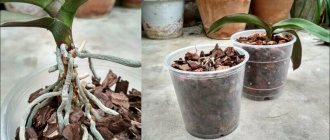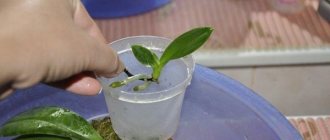Under natural conditions, orchids are fixed to the surface using a virtually open root system.
The roots grow widely, absorbing atmospheric moisture and carrying out the process of photosynthesis under the influence of light.
Indoors, orchid growing conditions are often far from natural.
In this case, the external signs of the plant will tell you what the plant is missing .
Why does improper root growth occur?
Improper root growth occurs for a number of reasons, each of which is associated with unfavorable growing conditions.
High temperature content
Cultivating an orchid in high temperatures often leads to drying out of the substrate . In search of moisture, the roots grow in different directions.
Over or under watering
The main reason for the massive development of aerial roots in an orchid is low air humidity . To prevent unfavorable processes, it is necessary to control the conditions of its growth, especially in winter.
As a rule, at this time the problem is associated with central heating radiators , which dry the air when turned on. The problem is especially acute in the window sill area, where flowerpots with orchids are usually located. In this case:
- the orchid is removed from sunlight or away from radiators;
- to maintain natural moisture, aerial roots are covered with moss;
- water only with soft water.
The opposite of underwatering is overwatering, which leads to lack of oxygen and rotting roots and also promotes the growth of aerial roots, which are thus saved from death.
Excessively dense soil
An improperly prepared substrate often provokes massive growth of aerial roots due to:
- poor air ventilation and oxygen starvation;
- waterlogging and root rotting.
In this case, the plant should be transplanted into a new substrate and the watering regime adjusted.
Lack of lighting
Insufficient lighting is one of the main factors leading to a decrease in plant immunity, diseases and root rot. To adapt to these conditions, the orchid grows numerous aerial roots that grow upward.
Place the orchid in unsuitable conditions
An incorrectly chosen place for an orchid is one of the reasons for its untimely death. Usually these plants are placed on the windowsill, because... they love sunlight. But there are also pitfalls here. If the windowsill is north-facing, there will not be enough light on it, and the orchid will turn pale and stretched out. On the south side, the orchid will experience scorching sun rays, and, as a result, burns on the leaves in the warm season. On the eastern and western windowsills the situation is a little better, however, there is not always enough sunlight there. In general, you can place an orchid on any window; you just have to additionally either illuminate the plant with a phytolamp, or shade it with blinds or a curtain. Read more in our article.
- Which window should I put the orchid on and should I rearrange the flower?
The condition of the flower largely depends on the choice of place for the orchid in the apartment. What kind of window will a whimsical plant like?
What can improper root growth cause?
Under unfavorable conditions, aerial roots are subject to various disturbances and infections.
Drying roots
This situation can be caused by:
- improper watering of the flower;
- humidification with water with a high salt concentration;
- weak watering during hot periods;
- excessive feeding.
Modern fertilizers are a concentrate of mineral elements, the wrong dosage of which can cause burns on the roots.
The appearance of mold
Mold on the roots is the first sign of the appearance of an infectious fungus . Its development is stimulated by a number of factors, especially quickly when exposed to the following:
- low temperature;
- overwatering;
- lack of light.
If the mold has affected only the soil and has not affected the root system, then:
- the top layer of soil is loosened and dried;
- Watering is carried out only after the soil has completely dried.
If mold has already captured the root system , the orchid must be replanted:
- the roots removed from the soil are washed under running warm water;
- remove diseased and dried ones;
- immerse the root system in the fungicide for 20 minutes.
The plant is planted in a prepared new substrate.
Redness of the root tips
This is not a disease or problem and occurs as a result of normal root growth.
Woodenness
The appearance of very hardened and woody roots occurs during the process of their natural aging . In this form, they often cause root infections, so they need to be pruned.
Rust or blackening of aerial roots
In some cases, blackening or a rusty color on the surface of the aerial roots due to salt deposition. This happens:
- when watering with water with high mineralization , when the roots in the middle of the pot do not have time to become saturated with moisture;
- with incorrect dosage of fertilizer , which results in burns to the roots or improper fertilizing. To prevent this from happening, apply fertilizer immediately after watering the orchid.
If the air in the room is dry, the situation may worsen sharply, so the following actions should be carried out immediately:
- the flowerpot is placed on a damp stand with pebbles, sand, moss, or a humidifier is regularly turned on;
- Irrigate only with low-salt water.
soften water at home using:
- special water filters;
- by adding 3 g of wood ash or 100 g of fresh peat to the water, which are stirred in 10 liters of water.
To prevent it from forming, the plant must be watered exclusively with soft water (melt, rain or settled water).
The appearance of pink or red areas on the roots
The following areas appear:
- in the hot season as a special tanning of the roots;
- as a result of fusarium.
Fusarium is an infectious disease caused by microscopic fungi. The disease manifests itself in softening of the roots, yellowing of the leaves and often ends in the death of the plant.
Use ordinary soil to replant the orchid
So, you have decided to replant your orchid. But here you can expect some difficulties. Firstly, never replant a flower in regular soil if you don’t want its roots to rot. Orchids only need a special substrate consisting of bark, moss, nut shells, coconut fiber and other components. In order not to collect the substrate in parts, it is better to immediately buy a ready-made mixture in the store. But if you wish, you can do it yourself.
Secondly, orchid roots need air; it’s not for nothing that they love to stick out of their pots. In nature, orchids grow on trees and are accustomed to free air exchange, so when replanting, do not completely cover the roots, do not compact the soil too much, so as not to injure the underground part of the plant. It is best to carry out transshipment with the addition of fresh soil. It is not necessary to change the pot.
What to do if the orchid roots have come out of the pot and are growing upward?
All actions should be aimed at normalizing the care of the orchid.
Adjusting the watering mode
To avoid problems with the roots, the substrate must dry completely between waterings. In the summer season, it is recommended to water the flower 2-3 times a week, in winter - no more than once every 10 days.
Important. When watering, first of all, they focus on the condition (humidity) of the substrate in the pot, and not on the recommended frequency of watering.
To saturate the orchid with moisture, do not water the plant from a watering can . In this case, water passes through the soil, only slightly wetting the roots. Proper watering is carried out by immersing the plant in a container of water for 10-15 minutes. or carry out abundant sprinkling from the shower.
Increase lighting
Orchid loves a large amount of diffused light , which will allow the roots to grow and develop normally:
- in autumn and winter, daylight hours should be extended to 12 hours using a fluorescent lamp;
- In order not to cause burns to the roots, the plant is protected from direct sunlight by slightly darkening the south window with plastic, matte film or any other material.
Comfortable lighting also helps strengthen the orchid's immunity.
Don't trim
There is no need to remove aerial roots or push them into a pot, as novice gardeners often do . Pruning is carried out only when rotting or other diseases of the roots are detected.
If the flower is cramped in the pot, replant it
Considering the negative factors that are associated with insufficient pot volume or too dense a substrate (oxygen starvation of the roots, waterlogging), the orchid should be replanted .
Compliance with the requirements of orchid cultivation does not require special skills. Even if problems arise, taking care of the plant will help restore the beautiful appearance of the orchid.
Choose an initially unhealthy orchid
The surest way to lose a desired plant is to choose the wrong specimen: sick, weakened, or simply old. Of course, in stores all the flowers seem beautiful and healthy, but be careful. Look not only at the flowers, but also at the roots and leaves of the orchid. Healthy roots should be green or silver-gray in color, with no brown areas. The leaves are juicy, elastic, rich green.
Make sure that parts of the plant are free of stains, mold, insects, and wrinkled areas. Move the potted plant around slightly. Is the orchid falling out? Then continue your search, this specimen has not yet taken root, and problems may arise with it after transportation.
Even if you made an excellent choice, the orchid may die if transported incorrectly. In frosty weather, the plant should be wrapped in newspaper, film and padding polyester. And remember, even in a shelter, a flower can be outside for no more than 5-10 minutes, otherwise it will freeze.
- How to choose an orchid - 7 secrets to a successful purchase
We tell you what to look for when choosing an orchid.
Useful tips
When planting an orchid, a five-centimeter layer of drainage made of expanded clay , perlite or polystyrene foam balls is poured onto the bottom of the pot. A prepared soil mixture 5-6 cm high is laid on top, and an orchid is placed on it.
The roots are covered with substrate and the pot with the plant is lowered into a container of water for a few minutes. We hope that after reading our article it becomes clearer to you what to do with orchid roots that grow outward. If you have any questions, write them in the comments, we will try to answer!
Replant the plant immediately after purchase
If immediately after purchasing you decide to transplant the orchid into a beautiful pot that you purchased in advance, you can say goodbye to your plant. It is unlikely that he will like the additional stress of a transplant. Give the orchid at least a few weeks to get used to the room conditions and your care. And it’s better not to touch it at all if there are no special problems with the plant. In a store-bought pot, it can easily develop and bloom for 1-2 years, and then, when the substrate becomes less capable of releasing moisture, feel free to replant it.
- Proper transplantation of orchids: putting everything on the shelves
Is it time to replant your orchid? Use our tips to do it right.
Actively feed orchids
The orchid does not like frequent and abundant feeding. It is enough to fertilize the plant 1-2 times a month and only during the growth period. If you bought a blooming orchid, do not rush to feed it, this will lead to stress in the plant. It’s better to wait until a new leaf begins to grow or a fresh arrow appears. Such signs are a signal for feeding.
For feeding, you can use special preparations for orchids or universal complex fertilizers. If you chose the latter, then the concentration of the solution should be 3-4 times less than that indicated in the instructions. The less feeding, the better for the orchid. It is not necessary to fertilize during the flowering period.
For orchids, only aqueous solutions of fertilizers should be used. Dry fertilizing can cause root irritation and plant death.
Be diligent with spraying the orchid
Yes, the orchid loves humidity, but you should not constantly spray its leaves and the upper part of the substrate. In general, our homes now contain hybrid orchids that can easily withstand low humidity. But the consequences of excessive moisture are rotting, the appearance of pests, etc. – not every plant will survive. Therefore, spray only in a dry and warm room and only in the first half of the day. You can also increase the humidity by using bowls of water placed near the flower or a humidifier.
Leave the orchid on the windowsill for the winter
In winter, the orchid suffers from lack of light, drafts and excessive dryness in the room. Leaving it on the windowsill above hot radiators and near an open window, you risk ruining the plant. It is best to transfer the flower to a table or cabinet, providing illumination with a phytolamp. If this is not possible, be sure to insulate the window sill, and during ventilation, remove the orchid to a warm corner of the room. When you return the plant to its place, place it in the same way as it was before.











